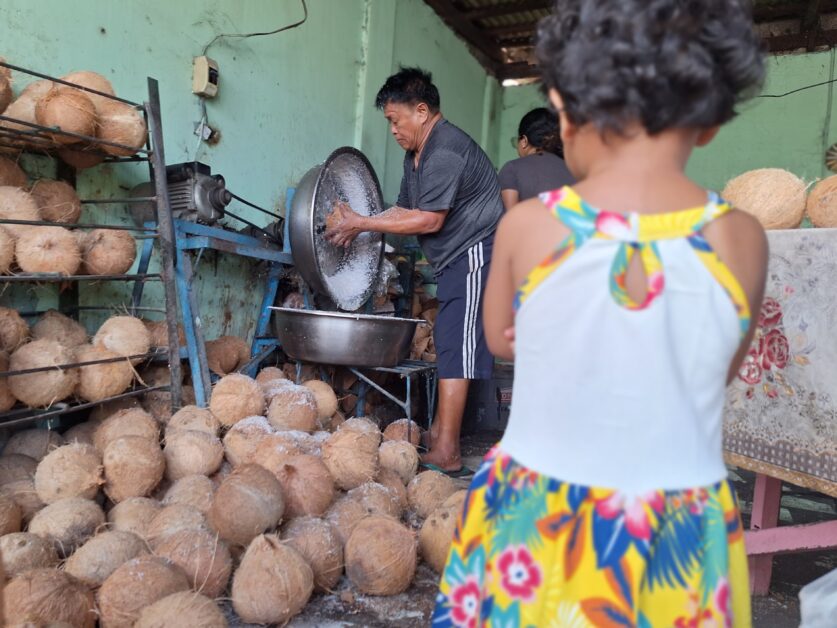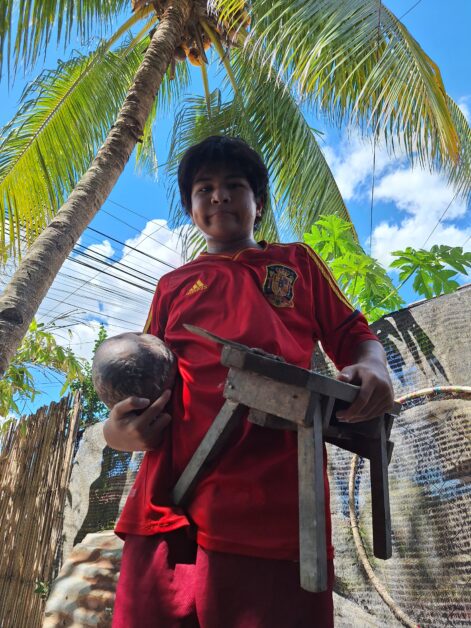GENERAL SANTOS CITY (MindaNews / 29 March) – A old Visayan riddle goes, “Kabayo ni Adan, dili mokaon kung dili kabay-an (Adam’s horse, won’t eat unless you ride it).”
The riddle refers to a traditional Filipino household tool called by its many names – kaguran or kudkuran in Mindanao and the Visayas, kayuran among Tagalogs, pangudkuran in Batanes and igad or pagigadan among Ilocanos.
In English, the names simply translate to grater or scraper, a tool mounted on one end of a bench.
The contraption was invented in the early 50s by Benjamin Almeda Sr., known as the father of Filipino inventors. He was credited for the invention of various food processing machines that are commonly used to this day.
To use the kaguran, one has to ride the bench horseback style, while manually grating the coconut with a sharp serrated steel tip on the end of a bench. The contraption is mainly used to grate or scrape the meat out of the shell of matured coconuts.
The process is done for easy extraction of coconut milk that is locally called gata, a well-known process among many Filipinos. Gata is mixed in many Filipino delicacies, either as viand or snacks.
“You cannot have gata without the kaguran unless you masticate the coconut,” jested retired government worker Bobby Catubig who is fond of cooking the famous binignit, a popular Holy Week staple that consists of sticky rice, fruits, tubers, and tapioca pearls cooked in coconut milk.

When there are festivities and important celebrations, the kaguran takes prominence in its role in delectable creamy food preparations, he said.
During the Holy Week, when most Filipinos cook native dishes and delicacies with coconut milk, kaguran or igad takes center stage.
Households without the traditional tool and rely on borrowing kaguran from their neighbors, usually become the butt of jokes in the neighborhood.
A favorite anecdotal alibi of those that did not prepare food during Holy Week or Halloween: “The neighbor failed to return the kaguran.”
Dying household practice
With the advent of technology, the manually-operated household grater is slowly fading from the kitchen of many Filipinos.
Many have resorted to having their coconuts grated by enterprising vendors who have included in their business motor-driven coconut grating and grains grinding.
Also, for those who do not want to flex their muscles in manually grating coconuts, there are now coconut milk being sold in packs, but more expensive than buying a coconut and having it grated.
The cost of a piece of coconut, to include grating, is P30 while a small 200ml pack of ready to pour coconut milk costs P35. The P30 grated coconut yields twice the amount of milk in the 200ml pack.

Catubig said relying on these modern options, lacks the emotion, the joy and human touch that essentially count in preparing good comfort food.
Gio, a minor at 13 years old, recalled what used to be a bonding time with his father whenever the family prepared food for a celebration, “Masaya kami. Kapag masaya masarap ang pagkain (We are happy. When you are happy, the food becomes delicious).”
He said he would tandem-ride with his father on the kaguran while grating coconut. The laughter and noise created by the horsing around on the kaguran adds to the joyful atmosphere during celebrations, he said.
Perhaps, the happiness created flows into the food being prepared, making it delicious and satisfying, Catubig said.
But, such a practice is about to vanish and will soon be a foreign thing to the coming younger generations. (Rommel G. Rebollido/MindaNews)



